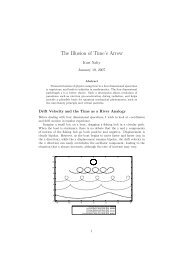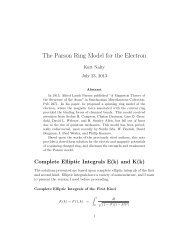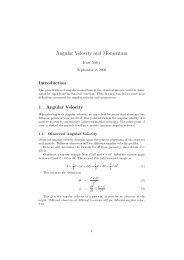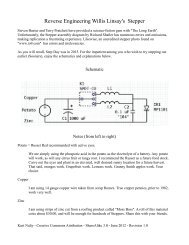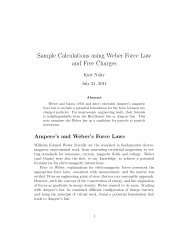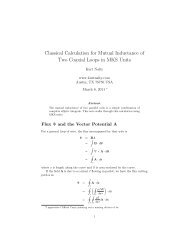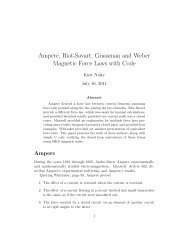Exercises with Magnetic Monopoles - Kurt Nalty
Exercises with Magnetic Monopoles - Kurt Nalty
Exercises with Magnetic Monopoles - Kurt Nalty
Create successful ePaper yourself
Turn your PDF publications into a flip-book with our unique Google optimized e-Paper software.
or so, effectively ruling out colocated charge as the origin of electron spin at<br />
the large scale.<br />
Let’s look at these numbers from another point of view. From the conserved<br />
magnitude of the duality rotated charge, we have<br />
c 2 q 2 e + q 2 m = [( 2.9989 · 10 8 m/s ) · (1.6<br />
· 10 −19 C )] 2<br />
= 2.3 · 10 −21 Amp 2 m 2<br />
For the conserved angular momentum, we have<br />
L = µq eq m<br />
= 1 4π 2¯h<br />
( ) 1<br />
µq e q m = 4π<br />
2¯h = 2h<br />
q e q m = 2h µ<br />
cq e q m = 2hc<br />
µ = 2(1.325 · 10−33 J s)(2.9989 · 10 8 m/s)<br />
4π10 −7 H/m<br />
= 3.16 · 10 −19 Amp 2 m 2<br />
Before proceding, we note that the ratio cq e q m /(c 2 q 2 e + q 2 m) = 137.04, the<br />
(inverse) fine structure constant.<br />
Returning to the discussion, the point of closest approach for the hyperbola<br />
xy = K 2 to the origin is K √ 2. With our values above, the angular<br />
momentum hyperbola never intersects the duality circle by a factor of 137,<br />
effectively ruling out any model of the electron as a simple colocated electric<br />
and magnetic charge combo.<br />
<strong>Magnetic</strong> Monopole and Charge Trajectories<br />
While we can rule out a colocated electric and real magnetic charge model<br />
for the electron, we have not excluded composite, separated assemblies of<br />
electric and magnetic charge, nor have we addressed imaginary magnetic<br />
charge, which will be a separate note.<br />
20




